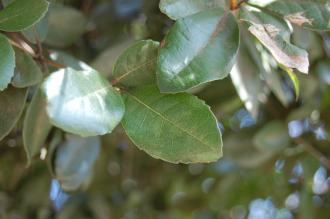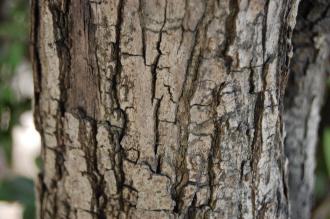
Quercus phillyraeoides (01/04/2015, Tokyo, Japan)
Position: Full sun to partial shade
Flowering period: Spring
Soil: Moist, well drained
Eventual Height: 10m
Eventual Spread: 10m
Hardiness: 7a, 7b, 8a, 8b, 9a, 9b
Family: Fagaceae
Quercus phillyraeoides is an evergreen tree or large shrub with a rounded habit. Its dark green glossy leaves are ovate with mildly serrate margins, up to 6cm long, 3cm broad, with pale green undersides. Its new leave appear bronze in color. Its gray bark is vertically fissured. Its monoecious flowers are wind pollinated and appear in dense clusters on new shoots. Its male flowers are in the form of catkins. Its fruit is an ovoid acorn.

Quercus phillyraeoides Leaf (01/04/2015, Tokyo, Japan)
Quercus phillyraeoides, commonly known as Ubame Oak, is native to south Japan Korea and south east China. In its native habitat it grows in thickets and open woods near coastal regions.
The etymological root of the binomial name Quercus is derived from the Latin name for an Oak tree, but some authorities believe it to be derived from the Celtic quer meaning ‘fine’ and cuez meaning ‘a tree’. Phillyraeoides is derived from the Latin meaning ‘similar to the genus Phillyrea‘.
The landscape architect may find Quercus phillyraeoides useful as a small evergreen specimen tree with interesting spring foliage. It is also suitable for use as a hedging species.

Quercus phillyraeoides Bark (01/04/2015, Tokyo, Japan)
Ecologically, Quercus phillyraeoides acorns are eaten by some mammals and birds.
Quercus phillyraeoides prefers moist, deep, fertile, well-drained soils. It prefers an acid to neutral pH of soil.
Quercus phillyraeoides requires little maintenance.

